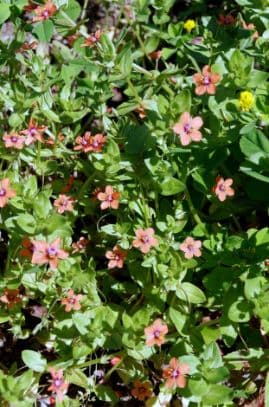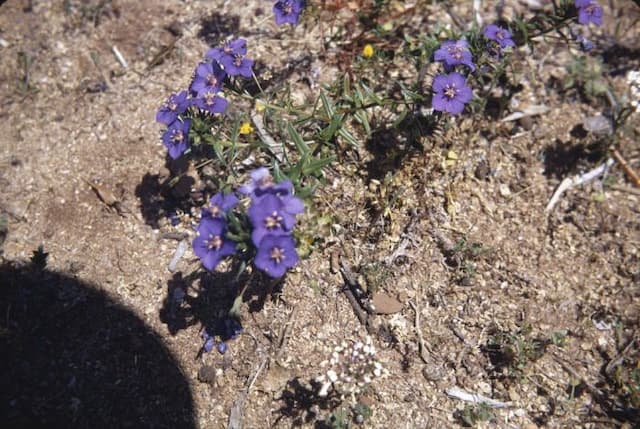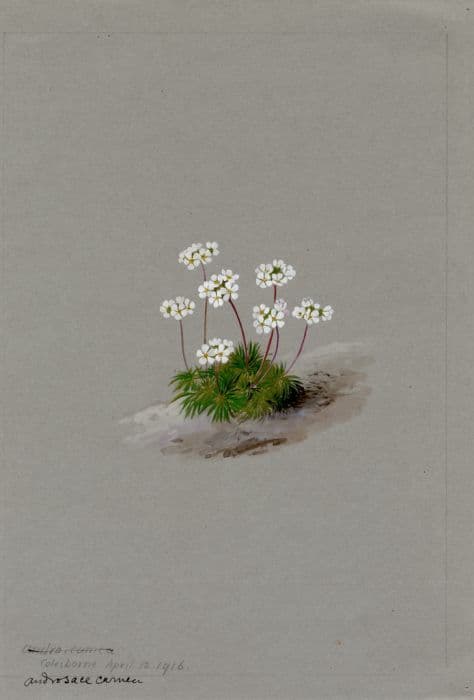Primrose Primula 'Crescendo Bright Red' (Crescendo Series) (Pr/poly)

ABOUT
The Primula 'Crescendo Bright Red' is notable for its striking, vivid red flowers that create a bold splash of color wherever they are planted. This variety, belonging to the Crescendo Series, boasts large, rounded blooms that resemble a full, frilly skirt with delicate textures. Each flower is comprised of a cluster of smaller, petal-like components, giving it a lush, dense look. The bright red of the blooms provides a stark contrast against the plant's lush green foliage, which consists of compact rosettes of oval-shaped leaves. The leaves have a crinkly appearance with a slight texture, contributing to the overall lushness of the plant. These leaves typically grow in a low mound or cluster at the base of the plant, setting an attractive stage for the flowers that rise just above them on sturdy stems. The brilliant hue of this Primula draws the eye and makes it an excellent choice for gardeners wanting to add a pop of color to their flower beds, borders, or containers.
About this plant
 Names
NamesSynonyms
English Primrose, Common Primrose.
Common names
Primula 'Crescendo Bright Red', Primula polyanthus 'Crescendo Bright Red'.
 Toxicity
ToxicityTo humans
Primrose (Primula 'Crescendo Bright Red') is generally considered to be non-toxic to humans. However, some individuals may experience mild discomfort or allergic reactions if they have sensitive skin or if they ingest parts of the plant. This can include symptoms like nausea, vomiting, or diarrhea, although instances of poisoning are quite rare. Always exercise caution and avoid ingesting plants that are not confirmed as edible.
To pets
Primrose (Primula 'Crescendo Bright Red') is considered to be non-toxic to pets as well. However, as with humans, sensitive animals could possibly experience mild gastrointestinal upset if they ingest the plant, such as vomiting or diarrhea. These symptoms are typically not severe, but it's always prudent to keep an eye on pets around plants and contact a veterinarian if any adverse reactions are observed.
 Characteristics
CharacteristicsLife cycle
Perennials
Foliage type
Evergreen
Color of leaves
Green
Flower color
Bright Red
Height
6 inches (15 cm)
Spread
8 inches (20 cm)
Plant type
Herb
Hardiness zones
5
Native area
Asia
Benefits
 General Benefits
General Benefits- Attractive Flowers - The Primula 'Crescendo Bright Red' features eye-catching bright red flowers that add a pop of color to any garden or landscape.
- Extended Bloom Period - This plant typically enjoys a long flowering season, providing color and interest over several months.
- Low Maintenance - It is generally easy to care for, requiring minimal maintenance once established in the right conditions.
- Cold Tolerant - The 'Crescendo' series is known for its tolerance to cold temperatures, making it suitable for gardens in cooler climates.
- Compact Size - Its small stature makes it an ideal choice for borders, rockeries, and containers where space is limited.
- Attracts Pollinators - The vibrant flowers attract bees, butterflies, and other pollinators to the garden, supporting biodiversity.
- Versatile - It can be used in various garden designs, from cottage gardens to modern urban landscapes.
 Medical Properties
Medical PropertiesThis plant is not used for medical purposes.
 Air-purifying Qualities
Air-purifying QualitiesThis plant is not specifically known for air purifying qualities.
 Other Uses
Other Uses- Photography subject: The vibrant red blooms of the Primula make it an excellent subject for photographers, particularly those specializing in macro or nature photography, providing stunning, vivid images.
- Educational tool: Botany teachers can utilize the Primula as a real-life example to elucidate plant biology topics for students, such as pollination mechanisms or petal arrangement.
- Art inspiration: Artists may find the bright red petals and contrasting green foliage of the Primula a perfect muse for paintings, illustrations, or fabric designs.
- Craft projects: The flowers of the Primula can be used in DIY craft projects, like creating bookmarks, floral arrangements, or pressed flower art.
- Non-traditional jewelry: Dried or preserved Primula flowers can be incorporated into unique hand-crafted jewelry pieces, like resin pendants or earrings.
- Theme gardens: Primula can be used as a signature plant for a 'fire' themed garden due to its bright red color, which can be accented by other red plants.
- Culinary decoration: Though not commonly eaten, the petals of Primula could be used as a natural garnish to add color to salads or desserts.
- Color therapy: The bright red color of the Primula is said to stimulate energy and can be used in color therapy gardens or spaces intended to invigorate and inspire.
- Wedding decor: The Primula’s bright red hue can be a part of wedding flower arrangements, particularly relevant for themes that employ vibrant or passionate colors.
- Seasonal celebrations: The red Primula is fitting for festive decor during holiday seasons like Christmas, where red is a prominent color in decoration schemes.
Interesting Facts
 Feng Shui
Feng ShuiThe Primrose is not used in Feng Shui practice.
 Zodiac Sign Compitability
Zodiac Sign CompitabilityThe Primrose is not used in astrology practice.
 Plant Symbolism
Plant Symbolism- Youth and Renewal: Primulas, including the 'Crescendo Bright Red', often bloom early in the spring, symbolizing new life and the fresh start associated with youth.
- Love and Affection: The red color of this Primula cultivar is traditionally associated with love and passion, making it an emblem of strong emotions and affection.
- Hope and Resilience: Primulas are hardy plants that can thrive in cool climates and return after harsh winters, symbolizing hope and the ability to overcome challenges.
- Positive Energy: The bright red hue of the 'Crescendo Bright Red' can represent positivity and a vibrant energy, often used to convey a sense of excitement or enthusiasm.
 Water
WaterPolyanthus, commonly known as Primula Crescendo Bright Red, should be watered regularly to keep the soil evenly moist but not waterlogged. Provide approximately an inch of water per week, which generally translates into a few gallons depending on the size of the plant and the environmental conditions. During hot weather or if the plant is in a particularly sunny spot, increase the frequency of watering to maintain consistent soil moisture. Water at the base of the plant to avoid wetting the foliage, which can lead to fungal diseases. Reducing watering in the winter months when the plant is not actively growing is essential to avoid root rot.
 Light
LightThe polyanthus prefers bright, indirect light or partial shade. It is best to position the plant in a spot where it can receive morning sunlight and afternoon shade, as too much direct sunlight can scorch the leaves. A north-facing window or a shaded area in the garden are ideal locations for the polyanthus, ensuring it gets the light it needs without excessive exposure to intense midday sun.
 Temperature
TemperaturePolyanthus thrives in cooler temperatures and can generally withstand temperatures down to 20°F and as high as 80°F. The ideal temperature range is between 50°F and 75°F. To promote flowering and maintain plant health, avoid exposing the polyanthus to extreme temperature fluctuations and protect it from frost and hot weather by positioning it accordingly or moving it indoors.
 Pruning
PruningPolyanthus benefits from regular deadheading of spent flowers to encourage continuous blooming and maintain a neat appearance. Pruning can be done as needed throughout the flowering season. The best time to prune polyanthus is after the main bloom period in the spring, trimming back foliage to promote healthy new growth. Remove any dead or yellowing leaves to help prevent disease.
 Cleaning
CleaningAs needed
 Soil
SoilThe best soil mix for Primula (Polyanthus) 'Crescendo Bright Red' should be well-drained, humus-rich, and loamy. A blend of two parts peat or coco coir, one part perlite or vermiculite, and one part rich compost or loam works well. The soil pH should be slightly acidic to neutral, ranging from 6.0 to 7.0 for optimal growth.
 Repotting
RepottingPolyanthus 'Crescendo Bright Red' should be repotted annually to replenish its soil and accommodate growth. It's best to repot these plants in late summer or early fall after they have finished flowering, giving them time to establish before the onset of winter.
 Humidity & Misting
Humidity & MistingPolyanthus 'Crescendo Bright Red' thrives in moderate to high humidity levels. Aim for a humidity range of 50-70% for best growth and flower production. Avoid excessively dry environments, which can lead to stress and poor plant health.
 Suitable locations
Suitable locationsIndoor
Place in bright, indirect light and keep soil moist.
Outdoor
Grow in partial shade; protect from harsh midday sun.
Hardiness zone
4-8 USDA
 Life cycle
Life cycleThe Primula 'Crescendo Bright Red' (Crescendo Series) typically begins its life cycle when seeds are sown in a moist, well-draining growing medium in late winter to early spring. As seedlings emerge and grow, they develop a rosette of leaves and, depending on the conditions, may enter a vegetative state before initiating flowering. Once mature, the plant produces bright red blossoms in mid to late spring, which attract pollinators for sexual reproduction, resulting in seed formation. After flowering, the plant may go through a period of dormancy during the hotter summer months, where it conserves energy. As temperatures cool and moisture increases in late summer to autumn, the plant may experience a second growth spurt, potentially leading to additional blossoming if conditions are favorable. The cycle concludes with the onset of winter, where the plant dies back, though it can re-emerge from the root system the following spring if it is a perennial variety within the series.
 Propogation
PropogationPropogation time
Spring-early summer
The most popular method of propagating Primula 'Crescendo Bright Red', commonly known as Primrose, is by division. Typically, this is done in the late winter to early spring, just before new growth begins. To propagate by division, carefully lift the plant from the ground using a fork or spade, ensuring to keep the root ball intact. Once lifted, gently tease apart the clumps of foliage and roots into smaller sections, each with several shoots and a portion of the root system. Replant the divisions immediately at the same soil depth they were previously growing and water them thoroughly to help establish the new plants. It is important to maintain even moisture as the divisions take root and begin to grow in their new locations.









